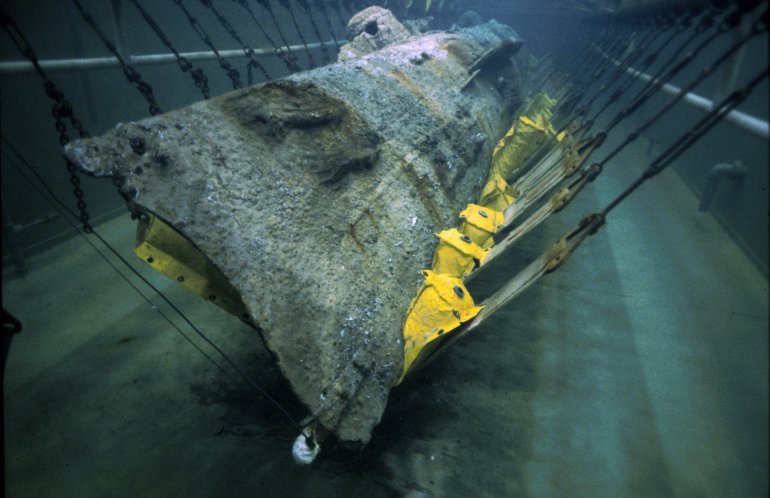The dead submarine crew hadn’t moved from their stations for nearly 150 years when the vessel was raised from the ocean in 2000. Whatever killed them happened so suddenly that they never made a run for the escape hatch. What’s more, they had no obvious physical injuries.
There was no major damage to the hull that could be definitively traced back to the day the H.L. Hunley, a 40-foot-long Confederate submarine, sank to the ocean floor off Charleston, South Carolina, on February 17, 1864.
Researchers had unsealed the crew compartment of the submarine, but they have yet to find conclusive evidence of how the eight men aboard died.
A number of theories have tried to explain the mystery of the Hunley: Maybe the crew went too deep, misjudged their oxygen supply and got trapped by the current. Maybe a nearby ship collided with the sub, throwing it off balance into chaotic waters. Maybe a bullet made through a porthole, killing the captain and leaving a beleaguered crew adrift at sea.
But in research published Wednesday in the journal Plos One, one group of scientists thinks they’ve finally cracked the case of what killed the crew so swiftly.
Shrinking down, blowing up
The Hunley became the first sub to sink an enemy ship in battle: the USS Housatonic. But sometime after, it went down, too.
It sank the enemy ship with a 135-pound torpedo, which was filled with black powder and attached to a pole 16 feet from the ship’s hull. The study authors say the torpedo is the key — but many have wondered how an explosion could’ve killed the entire crew without leaving a trace.
To answer this question, biomechanist Rachel Lance designed a model of the Hunley, one-sixth the length of the 40-foot-long submarine. The model, built by Durham-based sculptor Tripp Jarvis, was christened the CSS Tiny.
Lance, then a graduate student at Duke University and an engineer with the Naval Surface Warfare Center, decided she would set off test explosions next to the model submarine. So she found an eight-acre pond on a family-run farm in St. Louis, North Carolina. Bert Pitt of Pitt Family Farms agreed to let Lance use the pond to conduct her experiments.
“Initially, when she was talking about blasting, I was a little concerned,” said Pitt, 65, a sixth-generation family farmer, whose grandchildren now make eight generations.
Pitt recalled the wires snaking into the lake and the charges that detonated beneath the surface, splashing water into the air like a large firecracker, he said. One of his grandkids got to press the button.
“It had a little geyser to it,” he said. “It was neat to see.”
Pitt, a self-proclaimed history buff, had always been interested in the Civil War. He has ancestors who were in the North Carolina Regiments, and at least one of them is buried in their own family graveyard. The house he lives in was built in 1830, before the Hunley sank.
He keenly eyed reports about the Hunley on the History Channel and the National Geographic Channel.
“They were sitting perfectly still in that submarine,” Pitt said. “I think people would like to know what did happen to the crew. Everything about the story is intriguing.”
Without a trace
Suspended inside the CSS Tiny was a small pressure gauge, which revealed how the sub’s own torpedo blast could have killed the Hunley crew without leaving a lasting mark: the shock wave created by the blast.
The shock wave hit the Hunley’s hull, which was less than an inch thick, said Lance, lead author of the new study. The metal bent ever so slightly but fast enough to transfer the blast wave to the inside of the cabin.
That wave then traveled through the cabin, hitting each of the eight crewmembers, traveling through their bodies. But the real damage, Lance said, probably occurred when the pressure wave reached their lungs.
“The issue is when it’s passing through (the tissues) and it suddenly hits air,” she said.
Shock waves, like sound waves, travel quickly in water and solids but not air. The wave slows as it hits the lung, Lance said, and “that energy has to transmit somewhere.”
The end result: The blood vessels in the lungs can rupture, known as a pulmonary hemorrhage.
“It was … noted that men could be killed or disabled at considerable distance” from an explosive, Dr. Thomas Chiffelle, a pathologist from Albuquerque, New Mexico, wrote in a 1966 report for the US Department of Defense. “The man or animal may be killed outright, without external signs of injury, but often with blood-tinged froth or frank blood appearing in the nose and mouth.”
It is possible to survive a blast wave from far enough, according to Chiffelle’s accounts. Witness accounts from the night of the Hunley’s sinking claimed that there was a blue light coming from the ocean. Some speculated that it was the Hunley crew signaling that they’d accomplished their mission.
Source: CNN







